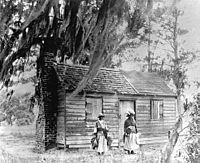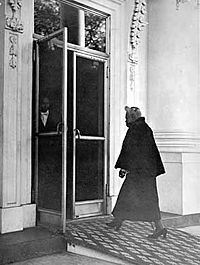Mary McLeod Bethune

Heritage: Mary McLeod Bethune
Heritage of the American Worker: Mary McLeod Bethune. A repot for my ANEW (Apprenticeships and Nontraditional Employment for Women) class.
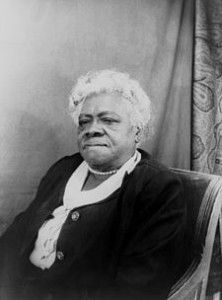 Mary Jane McLeod Bethune, photographed by Carl Van Vechten, April 6, 1949
Mary Jane McLeod Bethune, photographed by Carl Van Vechten, April 6, 1949
Mary Jane McLeod Bethune (July 10, 1875 – May 18, 1955) was an American educator and civil rights leader best known for starting a school for African-Americanstudents in Daytona Beach, Florida, that eventually became Bethune-Cookman University and for being an advisor to President Franklin D. Roosevelt.
Born in South Carolina to parents who had been slaves and having to work in fields at age five, she took an early interest in her own education. With the help of benefactors, Bethune attended college hoping to become a missionary in Africa. When that did not materialize, she started a school for African-American girls in Daytona Beach. From six students it grew and merged with an institute for African-American boys and eventually became the Bethune-Cookman School. Its quality far surpassed the standards of education for African-American students, and rivaled those of schools for white students. Bethune worked tirelessly to ensure funding for the school, and used it as a showcase for tourists and donors, to exhibit what educated African-Americans could do. She was president of the college from 1923 to 1942 and 1946 to 1947, one of the few women in the world who served as a college president at that time.
Bethune was also active in women’s clubs, and her leadership in them allowed her to become nationally prominent. She worked for the election of Franklin D. Roosevelt in 1932, and became a member of Roosevelt’s Black Cabinet, sharing the concerns of black people with the Roosevelt administration while spreading Roosevelt’s message to blacks, who had been traditionally Republican voters. Upon her death, columnist Louis E. Martin said, “She gave out faith and hope as if they were pills and she some sort of doctor.” Her home in Daytona Beach is a National Historic Landmark, herhouse in Washington, D.C. in Logan Circle is preserved by the National Park Serviceas a National Historic Site, and a sculpture of her is located in Lincoln Park inWashington, D.C.
Early life
Mary Jane McLeod was born near Mayesville, South Carolina, on a rice and cotton farm, in a small log cabin, the fifteenth of seventeen children to Samuel and Patsy McIntosh McLeod, both former slaves. Most of her siblings were born into slavery. Her mother worked for her former owner, and her father farmed cotton near a large house they called “The Homestead.”
After demonstrating a desire to read and write, McLeod attended Mayesville’s one-room schoolhouse, Trinity Mission School that was run by the Presbyterian Board of Missions of Freedmen. Her teacher, Emma Jane Wilson, became a significant mentor in her life. Wilson had attended Scotia Seminary (now Barber-Scotia College), so arranged for McLeod to attend the same school on a scholarship, which she did from 1888-1893. The following year, she attended Dwight L. Moody‘s Institute for Home and Foreign Missions in Chicago (now the Moody Bible Institute), hoping to become a missionary in Africa. However, she was told that she would not be able to go because black missionaries were not needed, so she instead planned to teach.
She married Albertus Bethune in 1898 and they subsequently lived in Savannah, Georgia, for a year while she did some social work. She was persuaded by a visiting Presbyterian minister named Coyden Harold Uggams (grandfather of entertainer Leslie Uggams) to relocate to Palatka, Florida, to run a mission school. She did so in 1899 and began an outreach to prisoners and ran the mission school. Albertus left the family in 1907 and did not seek a divorce, but relocated to South Carolina. He died in 1918.
 Career as an educator – Foundations with Lucy Craft Laney
Career as an educator – Foundations with Lucy Craft Laney
Bethune’s first position as a teacher was for a brief time at her former elementary school in Sumter County. In 1896, she began teaching at Haines Normal and Industrial Institute in Augusta, Georgia, which was part of a Presbyterian mission. It was founded and run by Lucy Craft Laney who impressed upon Bethune the foundations for her pedagogy. Laney was a former slave and ran her school with a Christian missionary zeal, emphasizing character and practical education for girls, but also accepted the boys who showed up on the steps of her school eager to learn. Laney’s mission was to better the perception that black people must fight their image of living with “shame and crime” through Christian moral education. Bethune spent only a year at Laney’s school, but said of her experience, “I was so impressed with her fearlessness, her amazing touch in every respect, an energy that seemed inexhaustible and her mighty power to command respect and admiration from her students and all who knew her. She handled her domain with the art of a master.”
Bethune was influenced deeply by Delaney and adopted many of her educational philosophies seeking to improve the conditions of black people by educating primarily women: “I believe that the greatest hope for the development of my race lies in training our women thoroughly and practically.” After one year at Haines, Bethune was transferred to the Kindell Institute in Sumter, South Carolina, where she had met her husband.
School in Daytona
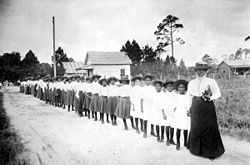 Mary McLeod Bethune with girls from the Literary and Industrial Training School for Negro Girls in Daytona, c. 1905.
Mary McLeod Bethune with girls from the Literary and Industrial Training School for Negro Girls in Daytona, c. 1905.
In October 1904, she rented a small house for $11.00 per month, making benches and desks out of discarded crates and obtaining items through charity. During this year Bethune used $1.50 to start the Literary and Industrial Training School for Negro Girls in Daytona. She had six students—five girls aged six to twelve, and her son, Albert. Bethune chose Daytona because its economic opportunities held more possibilities than Palatka: Daytona had become a popular tourist destination. The school bordered Daytona’s dump, and Bethune, parents, and church members raised money by making sweet potato pies, ice cream, and fried fish and selling them to construction crews. Ink for pens was made from elderberry juice, pencils from burned wood, and they scrounged local businesses for furniture. Bethune wrote later, “I considered cash money as the smallest part of my resources. I had faith in a loving God, faith in myself, and a desire to serve.” The school received donations of money, equipment, and labor from local black churches. Bethune also courted wealthy white organizations like the ladies’ Palmetto Club and asked powerful white men to sit on the board of the school; these included James Gamble (of Procter & Gamble) and Thomas H. White (of White Sewing Machines). A 1912 visit from Booker T. Washington helped to impress upon her the importance of appealing to white benefactors. Bethune had first gone to see Washington in 1896 and was impressed by his clout with his donors. She later recalled a dream she had of Washington where he showed her a soiled handkerchief and pulled from it a large diamond and said, “Here, take this and build your school.
Curriculum at the school started as a rigorous Christian life, having girls rise at 5:30 a.m. for Bible Study, classes in home economics and other industrial skills such as dressmaking, millinery, cooking, and other crafts that emphasized a life of self-sufficiency. Students’ days ended at 9 pm. Soon science and business courses were added, then high school courses of math, English, and foreign languages. However, Bethune constantly found it necessary to search for more funding; almost everywhere she went in her travels she begged for money for the school. A donation by John D. Rockefeller for $62,000 helped, as did her friendship with the Roosevelts. Through the Great Depression, the school was able to function meeting the educational standards of the State of Florida. From 1936 to 1942 she served only part-time as president of the college as she had duties in Washington, DC, and the lower funding reflected her absence. By 1942 Bethune was forced to give up the presidency of the school as it had begun to affect her health.
 Career as a public leader – National Association of Colored Women
Career as a public leader – National Association of Colored Women
In 1896, the National Association of Colored Women (NACW) was formed to promote the dual needs of black women. Bethune served as the Florida chapter president of the NACW from 1917 to 1925 and made it a mission to register as many black voters as possible, which prompted several visits from the Ku Klux Klan. Bethune served as the president of the Southeastern Federation of Colored Women’s Clubs from 1920 to 1925, an organization that served to amplify black women’s voices for better opportunities. Her presence in the organization earned her the NACW national presidency in 1924. Despite the NACW being underfunded, Bethune’s vision of the organization having a headquarters with a professional executive secretary came to fruition under her leadership when the organization purchased a Washington DC property at 1318 Vermont Avenue (with half the mortgage paid). Just prior to her leaving the presidency of the NACW, she saw it become the first black-controlled organization represented in Washington, DC.
She was invited to attend the Child Welfare Conference called by President Calvin Coolidge in 1928. In 1930 Herbert Hoover appointed her to the White House Conference on Child Health.
National Council of Negro Women
Bethune founded the National Council of Negro Women in New York City in 1935 bringing together 28 different organizations to form a council to facilitate the improvement of quality of life for women and their communities. About the organization, Bethune stated: “It is our pledge to make a lasting contribution to all that is finest and best in America, to cherish and enrich her heritage of freedom and progress by working for the integration of all her people regardless of race, creed, or national origin, into her spiritual, social, cultural, civic, and economic life, and thus aid her to achieve the glorious destiny of a true and unfettered democracy.” In 1938, the NCNW hosted the White House Conference on Negro Women and Children significantly displaying the presence of black women in democratic roles. They claimed their biggest impact came in getting black women into military officer roles in the Women’s Army Corps during World War II.
National Youth Administration
 Mary McLeod Bethune enters the White House c. 1950.
Mary McLeod Bethune enters the White House c. 1950.
The National Youth Administration (NYA) was a federal agency created with the support of the Works Progress Administration (WPA). Its purpose was to provide programs to promote relief and employment for young people. It focused on citizens aged sixteen to twenty-five years who no longer had regular attendance in school and did not have paid employment. Bethune lobbied the organization so aggressively and effectively for minority involvement that she earned herself a full-time staff position in 1936 as an assistant. Within two years, Bethune was appointed to position of Director of the Division of Negro Affairs, and as such, became the first African-American female federal agency head. She was responsible for releasing NYA funds to help black students through school based programs. She was the only black agent of the NYA who was releasing funds. She made sure that black colleges participated in the Civilian Pilot Training Program, which graduated some of the first black pilots. Awed by her accomplishments, the director of the NYA, said in 1939: “No one can do what Mrs. Bethune can do.”
Bethune’s determination helped national officials recognize the need for advancing the employable conditions for black youth. The NYA’s final report, issued in 1943, stated that, “more than 300,000 black young men and women were given employment and work training on NYA projects. These projects opened to these youth, training opportunities and enabled the majority of them to qualify for jobs heretofore closed to them.” Within the administration, Bethune used her position as Director of Negro Affairs to advocate for the appointment of black NYA officials to positions of political power. Bethune’s administrative assistants were numerous and served as liaisons between the National Division of Negro Affairs and the NYA agencies on the state and local levels. The high number of administrative assistants made up a reasonable work force commanded by Bethune. This attributed to better job and salary opportunities elsewhere. During her tenure Bethune also pushed national executives to approve a program of consumer education for blacks, a foundation for black crippled children and planned for a compile of studies pertaining to black workers’ education councils. However, these programs were rejected by national officials due to inadequate funding and fear of duplicating the work of private governmental agencies. The NYA was terminated in 1943.
Bethune played a dual role as close and loyal friend of Eleanor and Franklin Roosevelt. Eleanor Roosevelt respected Bethune to the extent that the segregation rules at the Southern Conference on Human Welfare in 1938, being held in Birmingham, Alabama, were changed on Roosevelt’s request so she could sit next to Bethune. Roosevelt frequently referred to Bethune as “her closest friend in her age group.” Bethune, in her turn took it upon herself to disperse the message of the Democratic Party to black voters, and make the concerns of black people known to the Roosevelts at the same time. She had unprecedented access to the White House through her relationship with the First Lady. She used it to form a coalition of leaders from black organizations called the Federal Council on Negro Affairs, but which came to be known as the Black Cabinet. The role of the Black Cabinet was to serve as an advisory board to the Roosevelt administration on issues facing black people in America. It gathered talented blacks in positions within federal agencies, creating the first collective of black people enjoying higher positions in government than ever before. It also served to show to voters that the Roosevelt administration cared about black concerns. The group gathered in Bethune’s office or apartment and met informally, rarely keeping minutes. Although as advisers they had little role in creating public policy, they were a respected leadership among black voters and were able to influence political appointments and disbursement of funds to organizations that would benefit black people).
When the Methodist Church facilitated the merging of the Daytona Normal and Industrial School and the Cookman College for Men into Bethune-Cookman College, Bethune became a member of the church. However, the church was largely segregated in the South, forming two separate denominations. Bethune was prominent in the primarily black Florida Conference, and though she worked to integrate the mostly white Methodist Episcopal Church, South, she protested initial plans for integration because they required separate jurisdictions based on race.
She dedicated her life to the education of both whites and blacks about the accomplishments and needs of black people, writing in 1938, “If our people are to fight their way up out of bondage we must arm them with the sword and the shield and buckler of pride – belief in themselves and their possibilities, based upon a sure knowledge of the achievements of the past.” And a year later, “Not only the Negro child but children of all races should read and know of the achievements, accomplishments and deeds of the Negro. World peace and brotherhood are based on a common understanding of the contributions and cultures of all races and creeds.”
One of her most effective methods of reaching this goal was to open her school on Sundays to tourists in Daytona Beach, showing off the accomplishments of her students, hosting national speakers on black issues, and taking donations. These Community Meetings were deliberately integrated. One black teenager in Daytona at the turn of the 19th/20th century remembers that as the most impressive aspect: “Many tourists attended, sitting wherever there were empty seats. There was no special section for white people.”
On the turnover of Plessy v Ferguson by the U.S. Supreme Court, Bethune took the opportunity to defend the decision by writing her opinion in the Chicago Defender in 1954:
There can be no divided democracy, no class government, no half-free county, under the constitution. Therefore, there can be no discrimination, no segregation, no separation of some citizens from the rights which belong to all…. We are on our way. But these are frontiers which we must conquer…. We must gain full equality in education …in the franchise… in economic opportunity, and full equality in the abundance of life.
Honors
 Mary Bethune bust by Selma Burke
Mary Bethune bust by Selma Burke
In 1930, journalist Ida Tarbell included Bethune as number 10 on her list of America’s greatest women. Bethune was awarded the Spingarn Medal in 1935 by the NAACP. Mary McLeod Bethune was the only black woman present at the founding of the United Nations in San Franciscoin 1945, representing the NAACP with W. E. B. Du Bois and Walter White. In 1949 she became the first woman to be given the Medal of Honor and Merit at the Haitian Exposition, Haiti‘s highest award. She served as the US emissary to the induction of President William V.S. Tubman of Liberia in 1949. She was also an honorary member of Delta Sigma Theta sorority.
On May 18, 1955, Bethune died of a heart attack. Her death was followed by editorial tributes in newspapers all over America. The Oklahoma City Black Dispatch stated she was, “Exhibit No. 1 for all who have faith in American and the democratic process.” The Atlanta Daily World said her life was, “One of the most dramatic careers ever enacted at any time upon the stage of human activity.” And in the Pittsburgh Courier, it was stated, “In any race or nation she would have been an outstanding personality and made a noteworthy contribution because her chief attribute was her indomitable soul.” The mainstream press praised her as well. Christian Century suggested, “the story of her life should be taught every school child for generations to come.” The New York Times noted she was, “one of the most potent factors in the growth of interracial goodwill in America.” The Washington Post read: “So great were her dynamism and force that it was almost impossible to resist her… Not only her own people, but all America has been enriched and ennobled by her courageous, ebullient spirit.” Her hometown newspaper, the Daytona Beach Evening News printed, “To some she seemed unreal, something that could not be…. What right had she to greatness?… The lesson of Mrs. Bethune’s life is that genius knows no racial barriers.”
Personal life
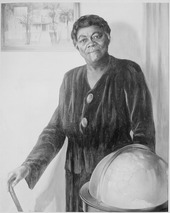 Painting of Bethune by Betsy Graves Reyneau
Painting of Bethune by Betsy Graves Reyneau
Bethune stood five feet four inches tall and cut a matronly figure even in her 30s. Unlike other black personalities who were effective in part for their lighter skin, Bethune was notable for how dark her skin actually was; she was often described as “ebony” in complexion. She carried a cane with her, not for support but for effect. She said it gave her “swank”. She was a teetotaler and preached temperance for African Americans, taking opportunities to chastise drunken blacks she encountered in public. Bethune stated more than once that the school and the students in Daytona were her first family and that her son and extended family came second. Her students often referred to her as “Mama Bethune.”
Her effectiveness in getting what she wanted was duly noted throughout her life. Dr. Robert Weaver, who served with her on Roosevelt’s Black Cabinet said of her, “She had the most marvelous gift of effecting feminine helplessness in order to attain her aims with masculine ruthlessness.” But when a white Daytona resident threatened Bethune’s students who walked in front of his home with a Winchester rifle, Bethune made it a priority to assuage his anger. The director of the McLeod Hospital recalled that, “Mrs. Bethune treated him with courtesy and developed such goodwill in him that we found him protecting the children and going so far as to say, ‘If anybody bothers old Mary, I will protect her with my life.'”
Self-sufficiency was a high priority throughout her life. Bethune invested in several businesses in her life including the Pittsburgh Courier, a black newspaper, and several life insurance companies, one of which she began: Central Life Insurance of Florida. When blacks were not allowed to visit the beach, she and several other business owners invested in Paradise Beach, purchasing a 2-mile (3.2 km) stretch of beach and the surrounding properties, splitting it up and selling it to black families, and allowing white families to visit. Paradise Beach was later renamed to Bethune-Volusia Beach. She also was a part of the Welricha Motel in Daytona, of which she was one-fourth owner.
Legacy
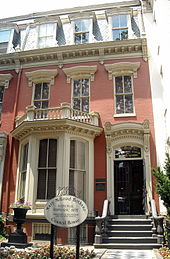 The Mary McLeod Bethune Council House National Historic Site in Washington, D.C.
The Mary McLeod Bethune Council House National Historic Site in Washington, D.C.
In 1973, Mary McLeod Bethune was inducted into the National Women’s Hall of Fame. On July 10, 1974, the anniversary of her 99th birthday, a sculpture was erected in her honor in Lincoln Park, Washington, D.C. by sculptor Robert Berks. The funds for the monument were raised by the National Council of Negro Women. It was the first monument to honor a black woman in a public park in the District of Columbia. The inscription on the pedestal reads “let her works praise her,” while the side is engraved with a passage from her “Last Will and Testament”:
I leave you love. I leave you hope. I leave you the challenge of developing confidence in one another. I leave you a thirst for education. I leave you a respect for the use of power. I leave you faith. I leave you racial dignity. I leave you a desire to live harmoniously with your fellow men. I leave you a responsibility to our young people.
Approximately 250,000 people attended the unveiling ceremony, including Shirley Chisholm, the first African American woman elected to Congress.
In 1985 the US Postal Service issued a stamp in her honor. In 1989 Ebony Magazine listed her on their list of “50 Most Important Figures in Black US History”, and named her again in 1999, Ebony Magazine included Mary McLeod Bethune as one of the 100 Most Fascinating Black Women of the 20th century. In 1991, the International Astronomical Union named the Bethune Patera on planet Venus in her honor. In 1994, the National Park Service acquired Bethune’s last residence, the Council House at 1318 Vermont Avenue, NW: the headquarters for the NACW. It became the Mary McLeod Bethune Council House National Historic Site.
Schools are named in her honor in Los Angeles, Chicago, San Diego, Dallas, Palm Beach, Florida, Moreno Valley, California, Minneapolis, Ft. Lauderdale, Atlanta, Philadelphia, Folkston and College Park, Georgia, New Orleans, Rochester, New York, and Jacksonville, Florida. In 2002, scholar Molefi Kete Asante listed Mary McLeod Bethune on his list of 100 Greatest African Americans.
In 2004, Bethune-Cookman University celebrated its hundredth anniversary. It currently sits on 82.2 acres (333,000 m2) in Daytona Beach. There are now 40 buildings that educate approximately 3,400 students from almost every state in the United States and 35 countries, and the school is located on Mary Mcleod Bethune Boulevard, which was once 2nd Avenue. The university offers 35 majors in six major colleges: arts and humanities, business, education, nursing, social science, and science engineering. The university’s website contends that, “the vision of the founder remains in full view over one-hundred years later. The institution prevails in order that others might improve their heads, hearts, and hands.” The university’s vice president recalled her legacy in saying, “During Mrs. Bethune’s time, this was the only place in the city of Daytona Beach where Whites and Blacks could sit in the same room and enjoy what she called ‘gems from students’—their recitations and songs. This is a person who was able to bring Black people and White together.”
There is a historical marker in Mayesville, Sumter County, South Carolina, commemorating her birthplace.

